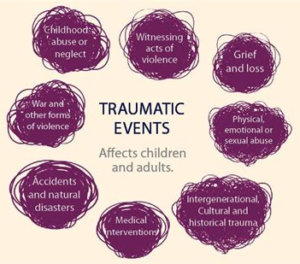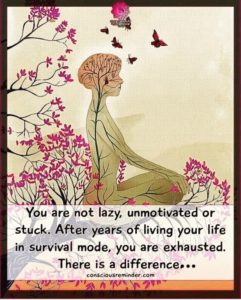 Trauma is an epidemic! 84% of adults with mental health issues like Depression, Anxiety Disorders, Oppositional Defiant Disorder, Bipolar Disorder, etc., have histories of trauma; that is, trauma appears to be related to most mental health issues! This is not surprising, since each year 71% of children are exposed to violence, 3 million children are maltreated or neglected, and up to 10 million children witness violence against their mothers. One in four girls and one in six boys are sexually abused before they reach age 18!
Trauma is an epidemic! 84% of adults with mental health issues like Depression, Anxiety Disorders, Oppositional Defiant Disorder, Bipolar Disorder, etc., have histories of trauma; that is, trauma appears to be related to most mental health issues! This is not surprising, since each year 71% of children are exposed to violence, 3 million children are maltreated or neglected, and up to 10 million children witness violence against their mothers. One in four girls and one in six boys are sexually abused before they reach age 18!
Trauma survivors often experience a sense of loss of control in their lives. It is important that my clients understand that they are in control of everything we do together, from start to finish.
I am trained and experienced in a variety of approaches to the treatment of trauma, including Bilateral Stimulation (BLS/EMDR), Internal Family Systems Therapy (IFS), Trauma Focused Cognitive Behavior Therapy (TF-CBT), and Hypnotherapy. Each has advantages and disadvantages, and they are not mutually exclusive (i.e., we can use one or more).
The effects of trauma on an individual can be looked at as a normal response to an abnormal situation. Individual trauma results from an event, series of events, or set of circumstances that is experienced by an individual as physically or emotionally harmful or life threatening and that has lasting adverse effects on the individual’s functioning and mental, physical, social, emotional, or spiritual well-being.
 External events or circumstances cause trauma, but an individual’s experience of the event(s) determines whether it is “traumatic.” The same event can be traumatic for one person and not for another. This is largely controlled by the person’s age at the time of the event, whether they were blamed or shamed, silenced or not believed, and whether the person who caused the event was a trusted caregiver, such as a parent or other close relative.
External events or circumstances cause trauma, but an individual’s experience of the event(s) determines whether it is “traumatic.” The same event can be traumatic for one person and not for another. This is largely controlled by the person’s age at the time of the event, whether they were blamed or shamed, silenced or not believed, and whether the person who caused the event was a trusted caregiver, such as a parent or other close relative.
 Trauma can cause adverse physical, social, emotional, or spiritual consequences. These can be short- or long-term. They can affect coping responses, relationships, or developmental tasks. They can also cause physiological changes and effects on well-being, social relationships, and spiritual beliefs. Trauma can change the brain; but so does learning a phone number. It is important to remember that biology is not destiny!
Trauma can cause adverse physical, social, emotional, or spiritual consequences. These can be short- or long-term. They can affect coping responses, relationships, or developmental tasks. They can also cause physiological changes and effects on well-being, social relationships, and spiritual beliefs. Trauma can change the brain; but so does learning a phone number. It is important to remember that biology is not destiny!
Trauma should be considered when seeking medical treatment for you or your children. At the very least, physicians should administer and consider the results of the Adverse Childhood Experiences Scale (ACES), which is a 10-item questionnaire that identifies potentially traumatic events that can occur in childhood. ACEs can include divorce, violence, abuse, and growing up in a family with mental health or substance use problems. Toxic stress from ACEs can change brain development and affect how the body responds to stress. ACEs have been linked to chronic health problems, mental illness, and substance misuse in adulthood.
Components of the Trauma Treatment Process: No matter which specific treatment you select, it will have each of the following elements. Note that some steps overlap, and some are a bit out-of-order. That’s because they were twisted around to spell the word “practice!”
Psychoeducation – General information about the specific type of trauma experienced, formation and management of memories. as well as common emotional and behavioral responses to the event, both immediate and delayed. I will also provide information about your diagnosis, symptoms, and the usefulness of each model in treating that condition. If we have already met, chances are I already started this step!
Relaxation – Training in specific techniques for bringing about the “relaxation response.” This is critical, because it is impossible to be both relaxed and tense at the same time.
Affective (emotional) expression and modulation (control) – Many of us have been taught from an early age to carefully control our emotions, keeping them “in check,” so as not to disturb other people. This is especially true of trauma survivors. For example, children who are traumatized often learn to hide their emotions to avoid hurting their parents. During this phase I will teach and encourage you to express those emotions safely.
Cognitive (thinking) coping and processing – Many trauma survivors learn to avoid thinking about the traumatic event(s); however, this is rarely completely successful, with “intrusive” thoughts interfering with their day-to-day lives. During this phase, you will learn simple and effective techniques that can be used anywhere to manage those thoughts, controlling when they occur, and coping with them when they do.
Trauma narrative development and processing (BLS or hypnotherapy may be substituted here, if that is your choice) – When you are ready, having developed the skills necessary to manage problematic emotions and thoughts, I will help you to tell your story. This could take the form of a book, a video, a song, a poem, a series of drawings, or anything else that works for you. It is important to know that whatever form this takes, it will belong to you, and will never be seen by anyone without your permission. One of the goals of treatment is for you to be able to tell the story of the traumatic event(s) without experiencing any of the troubling symptoms that brought you to treatment. Either BLS/EMDR or hypnotherapy might be substituted at this step based on your preferences.
In vivo (real life) mastery of trauma reminders (triggers) – during this phase, you will learns to manage the events in your life, such as sounds, smells, touches, places, times of day, seasons of the year, holidays, etc., that might remind you of the trauma, “triggering” intrusive thought and emotions.
Conjoint sessions (with parents, partners, or other appropriate persons identified by the client) – You might want help in explaining to other persons what has happened to you, and how those traumatic events effect your behavior and needs today. This step is optional for adults but can be extremely helpful to you and your family, friends, etc., and can make additional support available to you. This step is an important part of the TF-CBT approach, but may not be included in IFS, hypnotherapy or BLS/EMDR.
Enhancing future safety and development – Research shows that trauma survivors may be at increased risk for future traumatic events. During this final phase of treatment, the therapist will assist the client in developing a “safety plan,” to prevent future trauma, or reduce the severity of such trauma. If the client is in danger, this phase of treatment may occur sooner in the process.
Internal Family Systems Therapy, also known as “parts work,” incorporates all of the above components, but not in the same linear, stepwise manner. If the client chooses either hypnotherapy of BLS/EMDR, those components are substituted for the Trauma Narrative step. The chief advantage of TF-CBT is for clients who need help explaining their trauma to others, such as parents or partners.